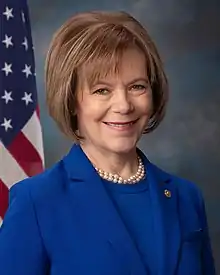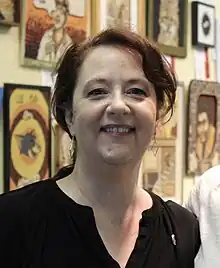Minnesota Democratic–Farmer–Labor Party | |
|---|---|
 | |
| Abbreviation | DFL |
| Chairperson | Ken Martin |
| Governor | Tim Walz |
| Lieutenant Governor | Peggy Flanagan |
| Senate President | Bobby Joe Champion |
| Senate Leader | Kari Dziedzic |
| House Speaker | Melissa Hortman |
| Founded | April 15, 1944 |
| Merger of | Minnesota Democratic Party and Minnesota Farmer–Labor Party |
| Headquarters | 255 Plato Boulevard East Saint Paul, Minnesota |
| Youth wing | Minnesota Young DFL (MYDFL) |
| Ideology | Modern liberalism Progressivism |
| National affiliation | Democratic Party |
| Colors | Blue |
| State Senate | 34 / 67 |
| State House | 70 / 134 |
| Statewide Executive Offices | 5 / 5 |
| U.S. Senate | 2 / 2 |
| U.S. House of Representatives | 4 / 8 |
| Website | |
| dfl | |
The Minnesota Democratic–Farmer–Labor Party (DFL)[1] is the affiliate of the Democratic Party in the U.S. state of Minnesota. As of 2023, it controls four of Minnesota's eight U.S. House seats, both of its U.S. Senate seats, the Minnesota House of Representatives and Senate, and all other statewide offices, including the governorship, making it the dominant party in the state.
The party was formed by a merger between the Minnesota Democratic Party and the Minnesota Farmer–Labor Party in 1944.[2] The DFL is one of two state Democratic Party affiliates with a different name from that of the national party, the other being the North Dakota Democratic–Nonpartisan League Party.
History


The DFL was created on April 15, 1944, with the merger of the Minnesota Democratic Party and the larger Farmer–Labor Party.[3] Leading the merger effort were Elmer Kelm, the head of the Minnesota Democratic Party and the founding chairman of the DFL; Elmer Benson, effectively the head of the Farmer–Labor Party by virtue of his leadership of its dominant left-wing faction; and rising star Hubert H. Humphrey, who chaired the Fusion Committee that accomplished the union and then went on to chair its first state convention.[4] By the party's second convention in 1946, tensions had re-emerged between members of the two former parties. While the majority of delegates supported left-wing policies, Humphrey managed to install a more conservative, anti-communist ally, Orville Freeman, as party secretary.[5] Some disaffected Farmer–Labor leaders such as Benson moved to the Progressive Party.[2]
Freeman was elected the state's first DFL governor in 1954. Important members of the party have included Humphrey and Walter Mondale, who each went on to be United States senators, vice presidents of the United States, and unsuccessful Democratic nominees for president; Eugene McCarthy, a U.S. senator who ran for the Democratic presidential nomination in 1968 as an anti-Vietnam War candidate; and Paul Wellstone, a U.S. senator from 1991 to 2002 who became an icon of populist progressivism.[6] The DFL has had varied success beginning in the late 1970s and through the late 2010s, in part due to the growth of single-issue splinter groups after reforms brought by the national party.[4]
After the 2022 Minnesota elections, the DFL became the dominant party in the state, retaining every executive office, winning majorities in the state House and Senate, and re-electing all incumbent Congressional Representatives. With their newly elected trifecta, the DFL pursued a progressive agenda in their first legislative session. Governor Tim Walz described the session as “the most successful legislative session, certainly in many of our lifetimes and maybe in Minnesota history.”[7] The newly elected government passed large expansions in welfare programs and spending. Notable policies passed include the expansion of abortion rights, new programs to provide reproductive healthcare, protection of gender affirming care,[8] the legalization of recreational cannabis, indexing education spending to inflation, investments in public transit, and paid sick leave for Minnesota workers.[8][9] Former President Barack Obama praised the state government's actions, saying that "Minnesota has made progress on a whole host of issues – from protecting abortion rights and new gun safety measures to expanding access to the ballot and reducing child poverty. These laws will make a real difference in the lives of Minnesotans."[10]
Current elected officials
Members of Congress
U.S. Senate
Democrats have held both of Minnesota's seats in the U.S. Senate since 2009:
.jpg.webp) Senior U.S. Senator Amy Klobuchar
Senior U.S. Senator Amy Klobuchar Junior U.S. Senator Tina Smith
Junior U.S. Senator Tina Smith
U.S. House of Representatives
Out of the eight seats Minnesota is apportioned in the U.S. House of Representatives, four are held by Democrats:
| District | Member | Photo |
|---|---|---|
| 2nd | Angie Craig | .jpg.webp) |
| 3rd | Dean Phillips | .jpg.webp) |
| 4th | Betty McCollum | .jpg.webp) |
| 5th | Ilhan Omar | .jpg.webp) |
Statewide officials
The Democratic–Farmer–Labor Party controls all five of the elected statewide offices:
State legislative leaders
Mayors
Current leadership
- Chair: Ken Martin (since 2011)
- Party Vice Chair: Marge Hoffa (since 2011)
- Second Vice Chair: Shivanthi Sathanandan (since 2021)
- Treasurer: Leah Midgarden (since 2021)
- Secretary: Ceri Everett (since 2021)
- Outreach Officer: Cheniqua Johnson (since 2021)
Past chairs
- Mark Andrew (1995-1997)
- Richard Senese (1997-1999)
See also
References
- ↑ "DFL Minnesota Home – MN Democratic-Farmer-Labor Party". DFL Minnesota. Retrieved November 10, 2021.
- 1 2 Nathanson, Iric (February 26, 2016). "The caucus that changed history: 1948's battle for control of the DFL". Minnesota Post.
- ↑ "Democrats, F-L, Complete Fusion". The Minneapolis Star (Minneapolis, Minnesota). April 15, 1944. p. Saturday Page 1.
- 1 2 “DEMOCRATIC-FARMER-LABOR PARTY.” n.d. Minnesota Historical Society. Accessed May 26, 2023. http://www2.mnhs.org/library/findaids/00586.xml .
- ↑ Mitau, G. Theodore (1955). "The Democratic-Farmer-Labor Party Schism of 1948". Minnesota History. 34 (5): 187–194. ISSN 0026-5497.
- ↑ Loughlin, Sean (October 25, 2002). "Wellstone Made Mark as a Liberal Champion". CNN. Retrieved June 23, 2014.
- ↑ "'Transformational' and also 'bonkers:' Minnesota Legislature ends big session". MinnPost. May 23, 2023. Retrieved May 26, 2023.
- 1 2 ""It's a good day for freedoms": Walz signs bills on reproductive freedom and trans refuge, ban on conversion therapy". www.cbsnews.com. April 27, 2023. Retrieved May 26, 2023.
- ↑ "Weed, abortion, paid leave, rebates and taxes: A look at what MN lawmakers got done this year". Duluth News Tribune. May 26, 2023. Retrieved May 26, 2023.
- ↑ Turtinen, Melissa (May 26, 2023). "Barack Obama tweeted about Minnesota as reason you should vote". FOX 9. Retrieved May 26, 2023.
Further reading
- Delton, Jennifer A. Making Minnesota Liberal: Civil Rights and the Transformation of the Democratic Party. Minneapolis: University of Minnesota Press, 2002.
- Haynes, John Earl. "Farm Coops and the Election of Hubert Humphrey to the Senate". Agricultural History 57, no. 2 (Fall 1983).
- Haynes, John Earl. Dubious Alliance: The Making of Minnesota's DFL Party. Minneapolis: University of Minnesota Press, 1984.
- Henrickson, Gary P. Minnesota in the "McCarthy" Period: 1946–1954. Ph.D. diss. University of Minnesota, 1981.
- Lebedoff, David. The 21st Ballot: A Political Party Struggle in Minnesota. Minneapolis: University of Minnesota Press, 1969.
- Lebedoff, David. Ward Number Six. New York: Scribner, 1972. Discusses the entry of radicals into the DFL party in 1968.
- Mitau, G. Theodore (Spring 1955). "The Democratic–Farmer–Labor Party Schism of 1948" (PDF). Minnesota History. 34 (5): 187–194. JSTOR 20175887.
.jpg.webp)

.jpg.webp)

.jpg.webp)